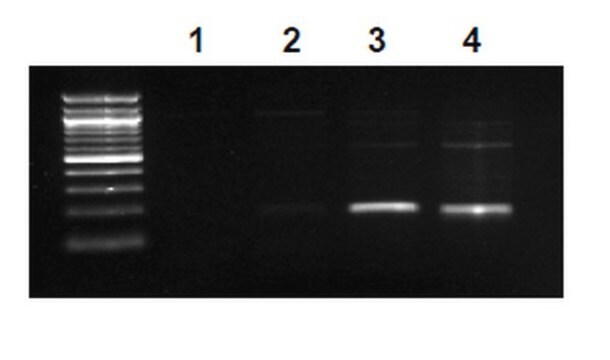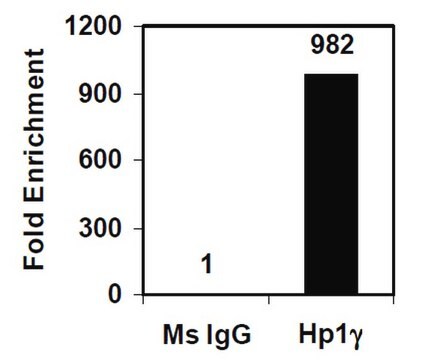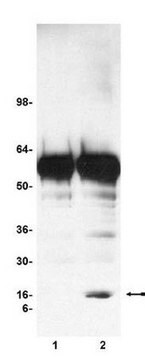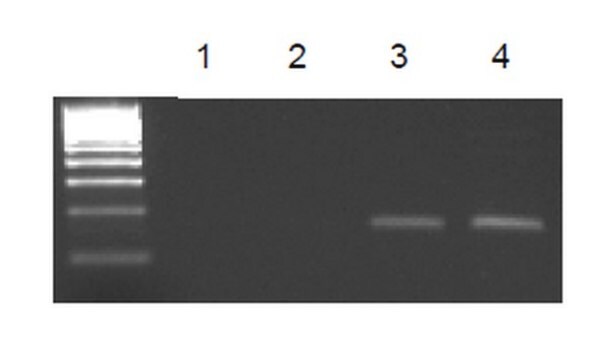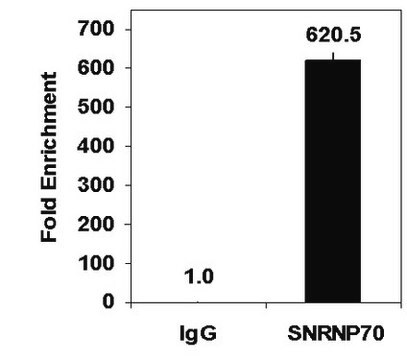17-10086
EZ-Magna ChIP® A/G Chromatin Immunoprecipitation Kit
Single day chromatin immunoprecipitation (ChIP) kit containing all necessary reagents to perform 22 individual chromatin immunoprecipitation (ChIP) reactions using magnetic A/G beads. Control primers included.
Recommended Products
Quality Level
manufacturer/tradename
Magna ChIP®
technique(s)
immunoprecipitation (IP): suitable
shipped in
dry ice
Related Categories
General description
- Magnetic bead-based rapid protocol allows performance of ChIP in as little as 1 day
- Blend of protein A+G bead blend allows ChIP using a broader range of antibodies than A or G alone
- Negative and positive control antibodies and control primer set to simplify validation of experimental procedure
- Includes spin columns to make DNA purification easier and more reliable - no more messy phenol-chloroform extractions
- Complete kit with all required reagents for reliable and reproducible results
- Compatible with ChIPAb+ validated antibody and primer sets
Chromatin Immunoprecipitation (ChIP) is an important technique allowing the analysis of in vivo interactions of proteins with genomic DNA. Any chromatin-associated or DNA binding protein can be analyzed with this technique, provided a good antibody to the protein exists. One can measure different proteins localized to a specific region of the genome, or the genome wide distribution of a specific protein. Another powerful application of this technique is to analyze changes in histone modifications that correlate with processes like transcription, mitosis or DNA repair.
Application
Epigenetics & Nuclear Function
Packaging
Components
ChIP Dilution Buffer
Low Salt Wash Buffer
High Salt Wash Buffer
LiCl Wash Buffer
TE Buffer
Cell Lysis Buffer
Nuclear Lysis Buffer
ChIP Elution Buffer (w/o Proteinase K)
Proteinase K
RNase A
10X Glycine
10X PBS
Protease Inhibitor Cocktail II
Anti-RNA polymerase II, clone CTD4H8
Normal Mouse IgG
Control Primers
Spin Filters
Collection Tubes
Bind Reagent A
Wash Reagent B
Elution Reagent C
Physical form
Storage and Stability
Legal Information
Disclaimer
Signal Word
Danger
Hazard Statements
Precautionary Statements
Hazard Classifications
Acute Tox. 4 Oral - Aquatic Chronic 3 - Eye Irrit. 2 - Flam. Liq. 2 - Resp. Sens. 1 - Skin Irrit. 2
Storage Class Code
3 - Flammable liquids
WGK
WGK 3
Flash Point(F)
55.4 °F
Flash Point(C)
13 °C
Regulatory Information
Certificates of Analysis (COA)
Search for Certificates of Analysis (COA) by entering the products Lot/Batch Number. Lot and Batch Numbers can be found on a product’s label following the words ‘Lot’ or ‘Batch’.
Already Own This Product?
Documents related to the products that you have purchased in the past have been gathered in the Document Library for your convenience.
Difficulty Finding Your Product Or Lot/Batch Number?
How to Find the Product Number
Product numbers are combined with Pack Sizes/Quantity when displayed on the website (example: T1503-25G). Please make sure you enter ONLY the product number in the Product Number field (example: T1503).
Example:
Additional examples:
705578-5MG-PW
PL860-CGA/SHF-1EA
MMYOMAG-74K-13
1000309185
enter as 1.000309185)
Having trouble? Feel free to contact Technical Service for assistance.
How to Find a Lot/Batch Number for COA
Lot and Batch Numbers can be found on a product's label following the words 'Lot' or 'Batch'.
Aldrich Products
For a lot number such as TO09019TO, enter it as 09019TO (without the first two letters 'TO').
For a lot number with a filling-code such as 05427ES-021, enter it as 05427ES (without the filling-code '-021').
For a lot number with a filling-code such as STBB0728K9, enter it as STBB0728 without the filling-code 'K9'.
Not Finding What You Are Looking For?
In some cases, a COA may not be available online. If your search was unable to find the COA you can request one.
Related Content
Protein and nucleic acid interaction reagents and resources for investing protein-RNA, protein-DNA, and protein-protein interactions and associated applications.
Our team of scientists has experience in all areas of research including Life Science, Material Science, Chemical Synthesis, Chromatography, Analytical and many others.
Contact Technical Service